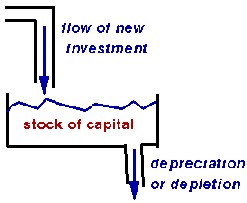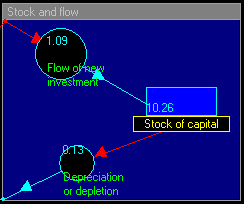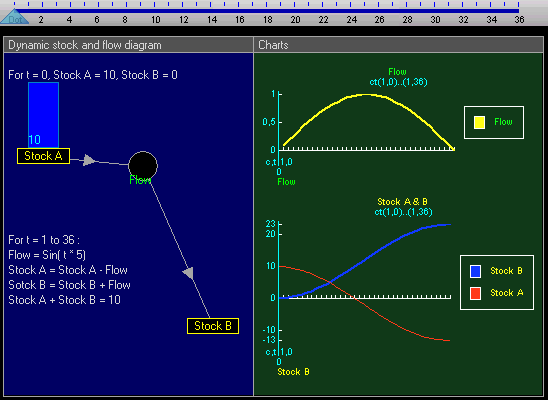
Stock and flow
Encyclopedia


Economics
Economics is the social science that analyzes the production, distribution, and consumption of goods and services. The term economics comes from the Ancient Greek from + , hence "rules of the house"...
, business, accounting, and related fields often distinguish between quantities that are stocks and those that are flows. These differ in their units of measurement
Units of measurement
A unit of measurement is a definite magnitude of a physical quantity, defined and adopted by convention and/or by law, that is used as a standard for measurement of the same physical quantity. Any other value of the physical quantity can be expressed as a simple multiple of the unit of...
. A stock variable is measured at one specific time, and represents a quantity existing at that point in time (say, December 31, 2004), which may have accumulated
Capital accumulation
The accumulation of capital refers to the gathering or amassing of objects of value; the increase in wealth through concentration; or the creation of wealth. Capital is money or a financial asset invested for the purpose of making more money...
in the past. A flow variable is measured over an interval of time. Therefore a flow would be measured per unit of time (say a year). Flow is roughly analogous to rate
Rate
In mathematics, a rate is a ratio between two measurements, often with different units. If the unit or quantity in respect of which something is changing is not specified, usually the rate is per unit time. However, a rate of change can be specified per unit time, or per unit of length or mass or...
or speed
Speed
In kinematics, the speed of an object is the magnitude of its velocity ; it is thus a scalar quantity. The average speed of an object in an interval of time is the distance traveled by the object divided by the duration of the interval; the instantaneous speed is the limit of the average speed as...
in this sense.
For example, U.S. nominal gross domestic product
Gross domestic product
Gross domestic product refers to the market value of all final goods and services produced within a country in a given period. GDP per capita is often considered an indicator of a country's standard of living....
refers to a total number of dollars spent over a time period, such as a year. Therefore it is a flow variable, and has units of dollars/year. In contrast, the U.S. nominal capital stock
Capital (economics)
In economics, capital, capital goods, or real capital refers to already-produced durable goods used in production of goods or services. The capital goods are not significantly consumed, though they may depreciate in the production process...
is the total value, in dollars, of equipment, buildings, inventories, and other real assets in the U.S. economy, and has units of dollars. The diagram provides an intuitive illustration of how the stock of capital
Capital (economics)
In economics, capital, capital goods, or real capital refers to already-produced durable goods used in production of goods or services. The capital goods are not significantly consumed, though they may depreciate in the production process...
currently available is increased by the flow of new investment and depleted by the flow of depreciation
Depreciation
Depreciation refers to two very different but related concepts:# the decrease in value of assets , and# the allocation of the cost of assets to periods in which the assets are used ....
.
Stocks and flows in accounting
Thus, a stock refers to the value of an asset at a balance date (or point in time), while a flow refers to the total value of transactions (sales or purchases, incomes or expenditures) during an accounting period. If the flow value of an economic activity is divided by the average stock value during an accounting period, we obtain a measure of the number of turnovers (or rotations) of a stock in that accounting period. Some accounting entries are normally always represented as a flow (e.g. profit or income), while others may be represented both as a stock or as a flow (e.g. capital).A person or country might have stocks of money
Money
Money is any object or record that is generally accepted as payment for goods and services and repayment of debts in a given country or socio-economic context. The main functions of money are distinguished as: a medium of exchange; a unit of account; a store of value; and, occasionally in the past,...
, financial assets, liabilities, wealth, real means of production
Means of production
Means of production refers to physical, non-human inputs used in production—the factories, machines, and tools used to produce wealth — along with both infrastructural capital and natural capital. This includes the classical factors of production minus financial capital and minus human capital...
, capital, inventories, and human capital
Human capital
Human capitalis the stock of competencies, knowledge and personality attributes embodied in the ability to perform labor so as to produce economic value. It is the attributes gained by a worker through education and experience...
(or labor power
Labor power
Labour power is a crucial concept used by Karl Marx in his critique of capitalist political economy. He regarded labour power as the most important of the productive forces of human beings. Labour power can be simply defined as work-capacity, the ability to do work...
). Flow magnitudes include income
Income
Income is the consumption and savings opportunity gained by an entity within a specified time frame, which is generally expressed in monetary terms. However, for households and individuals, "income is the sum of all the wages, salaries, profits, interests payments, rents and other forms of earnings...
, spending, saving, debt repayment, fixed investment
Fixed investment
Fixed investment in economics refers to investment in fixed capital, i.e., tangible capital goods , or to the replacement of depreciated capital goods which have been scrapped....
, inventory investment
Inventory investment
Inventory investment is a component of gross domestic product . What is produced in a certain country is naturally also sold eventually, but some of the goods produced in a given year may be sold in a later year rather than in the year they were produced. Conversely, some of the goods sold in a...
, and labor utilization.
Comparing stocks and flows
Stocks and flows have different units and are thus not commensurableCommensurability (philosophy of science)
Commensurability is a concept in the philosophy of science. Scientific theories are described as commensurable if one can compare them to determine which is more accurate; if theories are incommensurable, there is no way in which one can compare them to each other in order to determine which is...
– they cannot be meaningfully compared, equated, added, or subtracted. However, one may meaningfully take ratios of stocks and flows, or multiply or divide them. This is a point of some confusion for some economics students, as some confuse taking ratios (valid) with comparing (invalid).
The ratio of a stock over a flow has units of (units)/(units/time) = time. For example, the debt to GDP ratio
Debt to GDP ratio
In economics, the debt-to-GDP ratio is one of the indicators of the health of an economy.It is the amount of national debt of a country as a percentage of its Gross Domestic Product ....
has units of years (as GDP is measured in, for example, dollars per year whereas debt is measured in dollars), which yields the interpretation of the debt to GDP ratio as "number of years to pay off all debt, assuming all GDP devoted to debt repayment".
The ratio of a flow to a stock has units 1/time. For example, the velocity of money
Velocity of money
300px|thumb|Similar chart showing the velocity of a broader measure of money that covers M2 plus large institutional deposits, M3. The US no longer publishes official M3 measures, so the chart only runs through 2005....
is defined as nominal GDP / nominal money supply
Money supply
In economics, the money supply or money stock, is the total amount of money available in an economy at a specific time. There are several ways to define "money," but standard measures usually include currency in circulation and demand deposits .Money supply data are recorded and published, usually...
; it has units of (dollars / year) / dollars = 1/year.
In discrete time
Dynamical system (definition)
The dynamical system concept is a mathematical formalization for any fixed "rule" which describes the time dependence of a point's position in its ambient space...
, the change in a stock variable from one point in time to another point in time one time unit later is equal to the corresponding flow variable per unit of time. For example, if a country's stock of physical capital
Physical capital
In economics, physical capital or just 'capital' refers to any already-manufactured asset that is applied in production, such as machinery, buildings, or vehicles. In economic theory, physical capital is one of the three primary factors of production, also known as inputs in the production function...
on January 1, 2010 is 20 machines and on January 1, 2011 is 23 machines, then the flow of net investment
Net investment
In economics, net investment refers to an activity of spending which increases the availability of fixed capital goods or means of production. It is the total spending on new fixed investment minus replacement investment, which simply replaces depreciated capital goods....
during 2010 was 3 machines per year. If it then has 27 machines on January 1, 2012, the flow of net investment during 2010 and 2011 averaged
 machines per year.
machines per year.In continuous time
Dynamical system (definition)
The dynamical system concept is a mathematical formalization for any fixed "rule" which describes the time dependence of a point's position in its ambient space...
, the time derivative
Time derivative
A time derivative is a derivative of a function with respect to time, usually interpreted as the rate of change of the value of the function. The variable denoting time is usually written as t\,.-Notation:...
of a stock variable is a flow variable.
More general uses
Stocks and flows also have natural meanings in many contexts outside of business and its related fields. Thus stocks and flows are the basic building blocks of system dynamicsSystem dynamics
System dynamics is an approach to understanding the behaviour of complex systems over time. It deals with internal feedback loops and time delays that affect the behaviour of the entire system. What makes using system dynamics different from other approaches to studying complex systems is the use...
models. Jay Forrester originally referred to them as "levels" (for stocks) and "rates" (for flows).
A stock (or "level variable") in this broader sense is some entity that is accumulated over time by inflows and/or depleted by outflows. Stocks can only be changed via flows. Mathematically a stock can be seen as an accumulation or integration of flows over time - with outflows subtracting from the stock. Stocks typically have a certain value at each moment of time - e.g. the number of population at a certain moment.
A flow (or "rate") changes a stock over time. Usually we can clearly distinguish inflows (adding to the stock) and outflows (subtracting from the stock). Flows typically are measured over a certain interval of time - e.g., the number of births over a day or month.
Accounting, finance, etc.
| "Stock" | Possible units of stock | "Inflow(s)" | "Outflow(s)" | Possible units of flow |
| bank balance | euros | deposits interest | withdrawals | euros per month |
| inventory of lumber | board feet | incoming lumber | outgoing lumber | board feet per week |
| housing stock | dollars | housing investment | housing depreciation | dollars per year |
| equity shareholdings | shares (of 'stock Stock The capital stock of a business entity represents the original capital paid into or invested in the business by its founders. It serves as a security for the creditors of a business since it cannot be withdrawn to the detriment of the creditors... ') | purchases of shares | sales of shares | shares per month |
Other contexts
| "Stock" | Possible units of stock | "Inflow(s)" | "Outflow(s)" | Possible units of flow |
| CO2 in atmosphere | tons | tons emitted | tons sequestered | tons per day |
| guests in a hotel | persons | guests arriving | guests leaving | persons per day |
| population | persons | births immigration | deaths emigration | persons per year |
| water in bathtub Bathtub A bath , bathtub , or tub is a large container for holding water in which a person may bathe . Most modern bathtubs are made of acrylic or fiberglass, but alternatives are available in enamel over steel or cast iron, and occasionally waterproof finished wood... | liters | water pouring in | water draining out | liters per second |
| waste in disposal site | tons | dumping waste | decay of waste | tons per week |
| fuel tank | gallons | refueling | fuel consumption | gallons per month |
Calculus interpretation
If the quantity of some stock variable at time is
is  , then the derivative
, then the derivativeDerivative
In calculus, a branch of mathematics, the derivative is a measure of how a function changes as its input changes. Loosely speaking, a derivative can be thought of as how much one quantity is changing in response to changes in some other quantity; for example, the derivative of the position of a...
 is the flow of changes in the stock. Likewise, the stock at some time t is the integral
is the flow of changes in the stock. Likewise, the stock at some time t is the integralIntegral
Integration is an important concept in mathematics and, together with its inverse, differentiation, is one of the two main operations in calculus...
of the flow from some time when the time was zero until time t.
For example, if the capital stock
 is increased gradually over time by a flow of gross investment
is increased gradually over time by a flow of gross investment  and decreased gradually over time by a flow of depreciation
and decreased gradually over time by a flow of depreciationDepreciation
Depreciation refers to two very different but related concepts:# the decrease in value of assets , and# the allocation of the cost of assets to periods in which the assets are used ....
 , then the instantaneous rate of change in the capital stock is given by
, then the instantaneous rate of change in the capital stock is given by
where the notation
 refers to the flow of net investment, which is the difference between gross investment and depreciation.
refers to the flow of net investment, which is the difference between gross investment and depreciation.Example of dynamic stock and flow diagram




List of all the equations, in their order of execution in each time, from time = 1 to 36:



History
The distinction between a stock and a flow is elementary, and dates back centuries in accounting practice (distinction between an asset and income, for instance). In economics, the distinction was formalized and terms were set in , in which Irving FisherIrving Fisher
Irving Fisher was an American economist, inventor, and health campaigner, and one of the earliest American neoclassical economists, though his later work on debt deflation often regarded as belonging instead to the Post-Keynesian school.Fisher made important contributions to utility theory and...
formalized capital
Capital (economics)
In economics, capital, capital goods, or real capital refers to already-produced durable goods used in production of goods or services. The capital goods are not significantly consumed, though they may depreciate in the production process...
(as a stock).
Polish economist Michał Kalecki emphasized the centrality of the distinction of stocks and flows, caustically calling economics "the science of confusing stocks with flows" in his critique of the quantity theory of money
Quantity theory of money
In monetary economics, the quantity theory of money is the theory that money supply has a direct, proportional relationship with the price level....
(circa 1936, frequently quoted by Joan Robinson
Joan Robinson
Joan Violet Robinson FBA was a post-Keynesian economist who was well known for her knowledge of monetary economics and wide-ranging contributions to economic theory...
).
See also
- Stock (disambiguation)Stock (disambiguation)Stock is a representation of capital paid or invested into a business entity.Stock may also refer to:-Places:* Stock, Essex, England* Stock, Podlaskie Voivodeship, Poland* Stock Township, Harrison County, Ohio, United States...
- Flow (disambiguation)
- Systems thinkingSystems thinkingSystems thinking is the process of understanding how things influence one another within a whole. In nature, systems thinking examples include ecosystems in which various elements such as air, water, movement, plants, and animals work together to survive or perish...
- System dynamicsSystem dynamicsSystem dynamics is an approach to understanding the behaviour of complex systems over time. It deals with internal feedback loops and time delays that affect the behaviour of the entire system. What makes using system dynamics different from other approaches to studying complex systems is the use...
- Wealth (economics)

